DragonFire Balloon Adventures will be closed until farther notice!
Ballooning History ...
"... Balloonists can dawdle, lollygag, cast their fate to the wind and become part of the ebb and flow of nature, part of the sky itself, held aloft like any bird, leaf or spore. In that silent realm, far from the mischief and toil of society, all one hears is the urgent breathing of the wind and, now and then, an inspiring gasp of hot air ..."
Diane Ackerman, 'Traveling Light'
A Brief History of Hot Air Ballooning
The story of Hot Air Ballooning or ‘Lighter Than Air’ Aircraft began in the late 1700’s when two brothers (Joseph Michel Montgolfier and Jacques Etienne Montgolfier), began experimenting with paper vessels elevated by heated air. Over the course of several years, they developed a hot air balloon similar in design to the ones used today. Instead of using propane however, they powered their model by burning straw, manure and other material in an attached fire pit. By 1782, the Montgolfier's constructed a device (an ‘aerostat’) for taking people into the air - they named the craft ‘Seraphina’. This strange contrivance, was a 12-meter (40 ft) envelope made of linen lined with paper. Constructed in multiple sections, it was held together by some 2000 buttons. After some preliminary tryouts, the first public experiment was scheduled for Annonay on June 4, 1783.
The town square in Annonay (near Lyon, France) was packed, with people struggling to get a look at this craft. The balloon was spread out on the ground and tied to wooden posts. A fire, fueled by burning a mixture of straw and wool, was lit and the envelope began to fill. Under a menacing sky and with the wind beginning to rise, it took several men to hold the enormous balloon down until the order was given to let go. ‘Seraphina’ took off and a few minutes later was no more than a dot in the sky. The ‘aerostat’ reached an altitude of approximately 6500 ft and then gradually descended as the hot air cooled and escaped thru the porous envelope. Rushing after it, the local people found it in the middle of a vineyard two kilometers (a mile and a quarter) from where it had taken off.
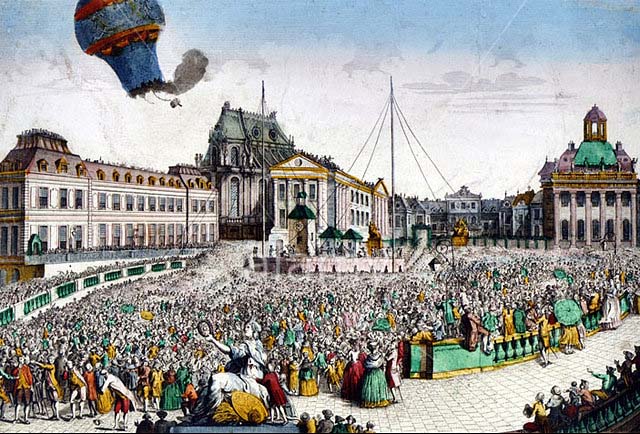
A Duck, a Sheep, a Chicken, and the Journey Begins
Launch of Aerostat ‘Reveillon' - Versailles 19 September 1783
On September 19,1783 they launched the Aerostat ‘Reveillon' ... the first hot air balloon with passengers. A sheep, duck and chicken were selected to be the first balloon passengers in the Montgolfiers' demonstration flight for King Louis XVI. The animals were uninjured, with only a minor injury to the roosters wing due of a kick from the sheep giving the King some assurance that human beings could breathe the atmosphere at the higher elevation.
In October, Jean-François Pilâtre de Rozier (the king's historian) unofficially became the first human being to ascend in a balloon. King Louis thought that the experiment might be dangerous and suggested that the Montgolfiers use a condemned criminal for the passenger. Pilâtre de Rozier argued that it would be a great honor to be the first person aloft and Louis conceded and allowed him to make the flight. The flight in a tethered balloon lasted about 4 1/2 minutes and reached an altitude of 84 feet.
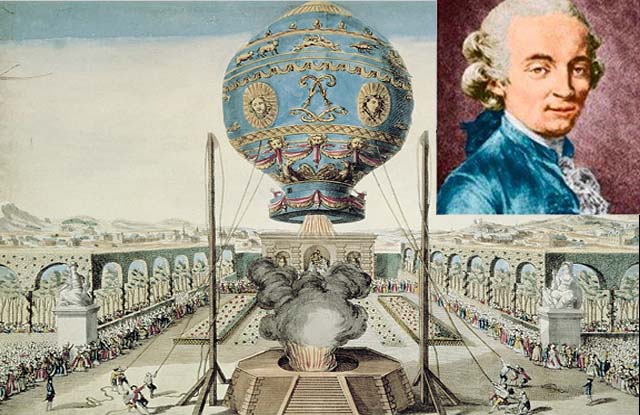
Chateau de la Muette November 21, 1783
Launch of first manned Aerostat piloted by Jean Francois Pilatre de Rozier and Marquis Arlandes
In November of 1783, de Rozier and a passenger made the first official manned flight in a balloon. Their free balloon flight lasted about 25 minutes and reached an altitude of about 500 feet flying over a large portion of Paris. The first balloons were usually free balloons meaning that they floated freely on the wind and it determined their course. Captive balloons are tethered to the ground with cables so that they do not float away on the wind.
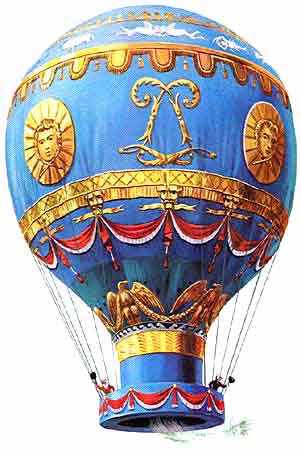
Aerostat ‘La Flesselles' - Lyons January 17, 1784
Balloons were known as Montgolfiers in the early days of aviation. In 1784, Joseph Montgolfier launched a new, giant balloon called "La Flesselles" from Lyons. Its 22 foot wide wicker basket carried 7 passengers aloft to a height of over 3,000 feet. It is said that though the flight was a bit rough at times, all passengers were thrilled with the voyage.
Early hot-air balloons had several problems, one being that they only stayed aloft as long as the air inside them remained warm. Re-heating the air while aloft was dangerous because sparks from the fires carried aboard to reheat the air frequently ignited the balloon fabric. It was not until after World War II that the propane burner for hot-air balloons was invented. J. A. C. Charles, the French physicist famous for Charles' Law, began experimenting with hydrogen balloons about the same time that the Montgolfiers were developing their hot-air balloons. Charles launched his first unoccupied balloon on August 27, 1783. It had taken four days to make enough hydrogen to fill it and it climbed to 3000 feet and floated within sight for more than an hour in the calm atmosphere that day. Charles first balloon eventually drifted off as the wind picked up and landed about fifteen miles, (24 km) from Paris where it was furiously attacked and shredded by terrified peasants that thought it was a demonic manifestation. In order to avoid similar panics in the future, King Louis XVI issued a decree explaining what balloons were, what they looked like and asking that they not be attacked again.
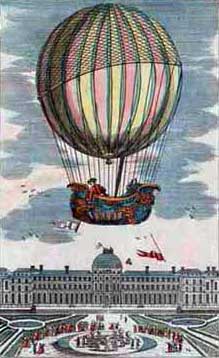
First manned flight in a Hydrogen Balloon - December 1, 1783
Charles and some associates made the first manned flight in a hydrogen balloon on December 1, 1783. They traveled more than twenty-five miles, or 40.3 km, in less than two hours. This balloon was similar to modern balloons in many ways. They carried a barometer and thermometer to conduct some atmospheric experiments. When they landed Charles decided that he wanted to fly alone for awhile and his associates then stepped out of the basket. The balloon then jumped rapidly to 9000 feet, and Charles discovered that the air was very cold and thin at that altitude. About a year later, an American doctor, John Jeffries, made the first scientific collection of atmospheric data from a balloon
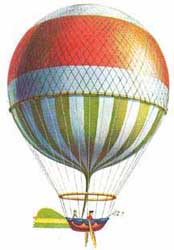
Jean Pierre Blanchard and Dr. John Jeffries
First successful voyage by air across the English Channel on January 7, 1783
Balloon fever soon spread like wildfire and was not restricted to France. Balloon fever spread to all European countries, England and Italy were at the top in the number of people experimenting with all types of balloons. Many of these balloons had attachments to try and help control the balloons, oars, wings, parachutes and propellers. None of these proved to be effective.
On January 7, 1785, Jean Pierre Blanchard (a French balloonist), and Dr. John Jefferies (an American physician), became the first to fly across the English Channel, traveling from Dover, England, to Calais, France. Blanchard also made the first balloon flights in Germany, Belgium, Poland, the Netherlands and the United States.
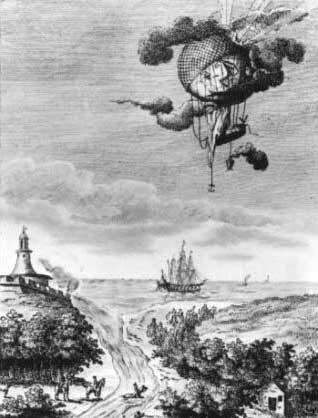
Flight of de Rozier and Pierre Romain - June 15, 1785
Jean-François Pilâtre de Rozier, continued as a pioneer in ballooning and he began to experiment with a combination of hydrogen and hot-air to lift his balloons. On 15th June, 1785, de Rozier and Pierre Romain, attempted to fly from Boulogne to England. At an altitude of about 2,950 feet (900 m) the hydrogen exploded and the two men were killed. They were the first aviators to lose their lives in a manned flight. As a result of this tragedy, the flamboyant historian secured a place in history that can never be supplanted ... he will be known not only the first person to fly, but also as the first person to die in a balloon.
The French brought their ballooning skills to America on January 9, 1793 when François Blanchard ascended in a balloon in Philadelphia. He carried a letter from President George Washington on his flight from Pennsylvania to New Jersey, creating the idea of air mail. President George Washington and a large crowd of onlookers witnessed the event.
Balloons were first commercialized in the United States when Charles Ferson Durant experimented with dropping leaflets from balloons in 1820. Durant was perhaps the world's first aerial litterbug and may also be the father of the propaganda bomb. A great showman, Durant would sometimes ascend very high in his balloons and allow them to burst. He would then use the ruptured balloon as a parachute to return safely to the earth. He also developed a portion of his performance where it would rain cats and dogs. In this part of the show, he put parachutes on the animals and threw them overboard - a practice that would not be acceptable today.
John Wise was one of the earliest commercial aeronauts performing at many county fairs and other entertainment venues throughout the United States. He made many ascents while engaged in this business and refined many aspects of ballooning as a result of his experience. One of his developments, the ripping panel, is still used. Wise devised the ripping panel to release the lifting gas rapidly so that the wind would not carry a landing balloon away.
Other hot air balloon designs and ambitious flights followed, but by 1800, the hot air balloon had been largely overshadowed by gas balloons. One exception to the decline of hot air balloons was the ‘smoke’ balloon. These balloons were lifted by hot air provided by a fire on the ground, and did not have any attached heat source. They simply shot up in the air, and then sank back to the ground. Their main use was as an attraction at traveling fairs in the United States in the late 1800s and early 1900s. The balloonist would put on a parachute or glider, and attach himself to a canvas balloon. Then, several assistants would hold the balloon over a fire pit, getting the air hotter and hotter, and so increasing the upward force. When the force was great enough -- and if the balloon hadn't caught on fire -- the assistants would let go and the balloonist would be launched into the air. When the balloon reached its highest point, the balloonist would detach and parachute to the ground.
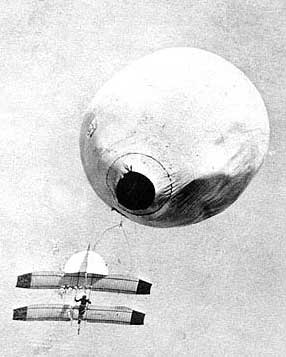
Daniel John Maloney - "Professor Lascaldes"
Daredevils take to the sky in large hot-air smoke balloons
One of these daredevils was Daniel John Maloney, a professional parachutist, who jumped under the name "Professor Lascaldes". During the summer of 1904, Maloney made numerous parachute jumps from hot-air balloons at resorts around Northern California. Maloney was hired to operate John J. Montgomery's tandem wing gliders and, after some considerable training, he became quite adept at maneuvering the aerial machine and managed to make controlled circles and reversing turns while aloft. Montgomery's tandem-wing gliders were carried aloft beneath large hot-air smoke balloons. An unfortunate accident in July 1905 leading to structural failure of the glider "The Santa Clara" caused Maloney's death.
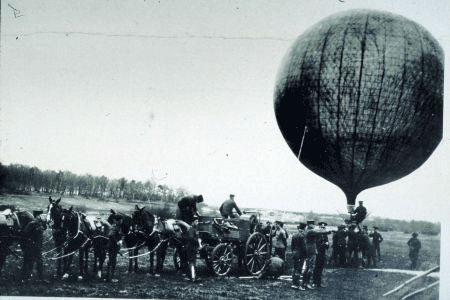
The military quickly adopts the use of balloons
The military was quick to exploit the use of balloons as a tactical devices. Balloons were first used as a mobile platform to view the country side. The balloon didn't work out that well but it did tend to scare the enemy. The Prussians used balloons against the French and the Americans used balloons in the civil war (1861-1865) and the Spanish-American war (1898). The British used balloons for aerial photography, allowing large areas to remain under surveillance. World War I saw an expanded use of balloons. The shape of the balloon changed from the classic sphere shape to an elongated tube with tail fixtures. The balloons were tethered and used as observation posts and later steel cables were hung from them, forcing airplanes to fly above them and as a result, decreasing the accuracy of airplanes dropping bombs. At the beginning of World War II, this type of balloon was used in the defense of London.
Don Piccard, an influential modern ballooning giant, started flying in the U.S. Navy at Lakehurst, New Jersey in 1933. After world war II, he modified a Japanese war balloon and developed a side inflation technique using hydrogen bottles that is still in use today. He added an aluminum basket and a drag rope, and on February 16, 1947 in Minneapolis, MN, made the first ascension in the United States. In 1954 he formed the Balloon Club of America. It eventually merged with the Wingfoot Lighter Than Air Club of Akron, to become the Balloon Federation of America. Today the BFA is sanctioned by the National Aeronautic Association and the Federation Aeronautique Internationale, as the official representative for sport ballooning in America.
Since the 1960s, traditional hot air balloons have enjoyed a renaissance, due in part to Ed Yost and Raven Industries. Yost and his partners founded Raven Industries in 1956, to design and build hot air balloons for the United States Navy's Office of Naval Research. The ONR wanted the balloons for short-range transportation of small loads. Yost and his team expanded on the basic concept of the Montgolfier brothers' balloon by adding a propane burner system, new envelope materials, a new inflation system and many other safety features. In 1955 he designed a multiple burner propane heater and inflated a 39 foot diameter polyethylene balloon. In 1960 Yost completed the first successful modern day hot air balloon. It had a volume of 30,000 cubic feet, was about 40 feet in diameter, made of a mylar / nylon laminate and had a lifting power of about 450 pounds. He ascended to about 9,300 feet in a 3 hours and 15 minute flight.

Mass ascension of hot air balloons at Albuquerque Fiesta
As more and more people got involved in the sport of ballooning, many new companies got into the market. Over the years, designers have continued to modify hot air balloons, adding new materials and safety features, as well as developing creative envelope shapes. Innovations have continued and designs have improved to the point where some manufacturers have increased basket size and load capacity and are delivering balloons that can easily carry up to 20 passengers! This remarkable technology continues to inspire and enthrall people all over the world.
Adventures with DragonFire Balloon
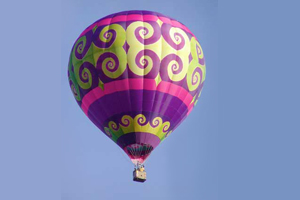
Acton, MA
Lucy on a local flight

Stow, VT
Lucy in Vermont
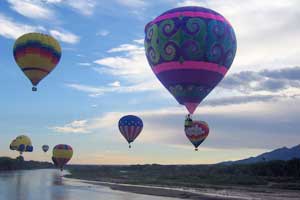
Albuquerque, NM
Lucy at Fiesta

Castille, NY
Lucy in upstate NY
